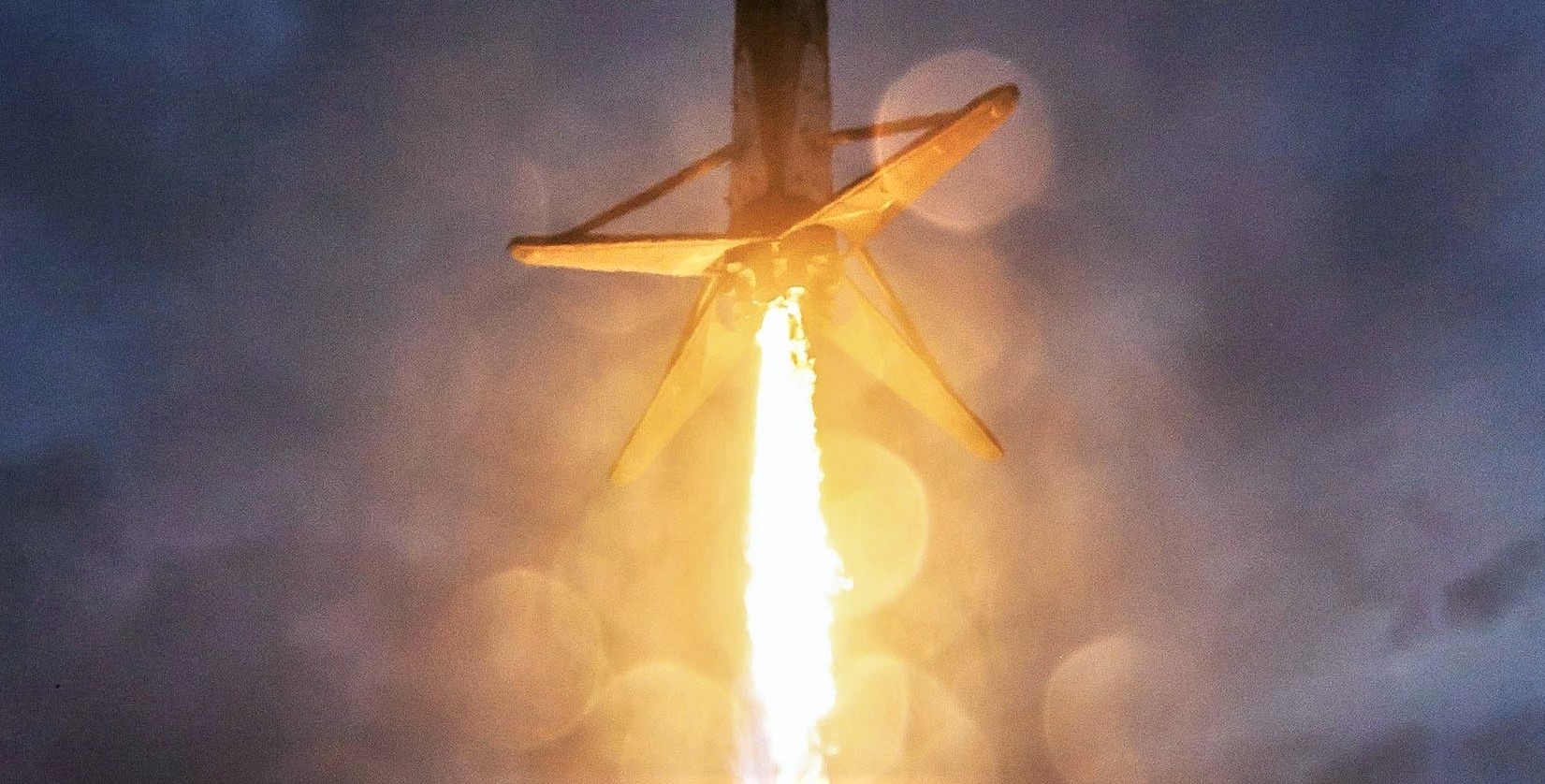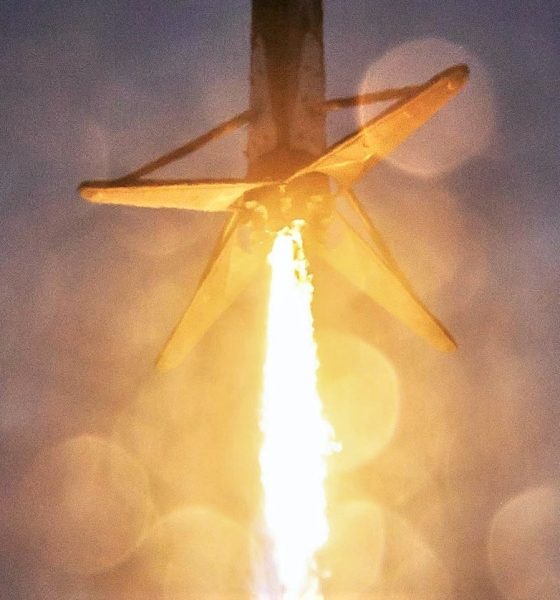

News
SpaceX set for Falcon Heavy triple booster landing, hottest center core reentry yet
SpaceX’s third Falcon Heavy launch is ready to wow crowds once more with a synchronized side booster landing at Cape Canaveral and a center core recovery attempt more than 1200 km (750 mi) off the coast of Florida.
Based on the fact that Falcon Heavy’s STP-2 center core (B1057) is set to smash SpaceX’s current record for drone ship downrange distance, chances are good that B1057 will separate from the upper stage and payload traveling faster and higher than any recoverable Falcon booster before it. In short, the fresh Block 5 booster will likely be subjected to the most extreme (hottest) atmospheric reentry a SpaceX booster has ever experienced before a serious recover attempt. Thankfully, the earliest the booster can be expected to fly again is H2 2020, giving SpaceX at least a full year for a cautious, careful refurbishment.
Weather and rocket pending, Falcon Heavy Flight 3 will lift off with the Department of Defense’s (DoD) Space Test Program-2 (STP-2) mission as early as 8:30 pm PDT (11:30 pm EDT, 03:30 UTC) on June 24th. Around 2.5 minutes after liftoff, both side boosters will deploy from the center core/upper stage stack, flip around, and burn hard to entirely cancel out their eastbound momentum, picking up speed as they head back to the Florida coast.
After a leisurely 6-minute coast and reentry burn, the booster pair are set to land at SpaceX’s Landing Zones 1 and 2 roughly 8.5 minutes after launch. Pictured below (with the same boosters, no less), B1052 and B1053 will hopefully replicate the simultaneous landings that followed their picture-perfect April 11th launch debut. Despite being the first flight-proven SpaceX boosters to launch as part of a US military mission (STP-2), both boosters will also simultaneously tie SpaceX’s current record for Block 5 booster turnaround (74 days), although the company’s overall record (71 days) still stands.

Meanwhile, STP-2’s fresh Falcon Heavy Block 5 center core – B1057 – will still be soaring above Earth at hypersonic speeds and high altitudes after its side booster companions have successfully come to a rest. Incredibly, the booster’s absolutely critical reentry burn – used to quite literally cushion the blow and minimize reentry heating with the rocket’s engine exhaust – will start at T+8:53 after liftoff. A full 2.5 minutes later (T+11:21), center core B1057 will attempt to land aboard drone ship Of Course I Still Love You, stationed ~1240 km (750 mi) off the coast of Florida.
For reference, Falcon Heavy Flight 2’s Block 5 center core landed aboard OCISLY around T+9:50 after launch, meaning that STP-2’s center core will be in the air – sans any sort of boostback or altitude-raising burn – for a solid 90 extra seconds – 15% longer. To get that extra flight time, B1057 will have to be traveling significantly faster and reach a much higher altitude than its predecessor. In short, B1057 will likely experience the most intense reentry conditions a Falcon booster has ever been subjected to. The current record-holder, B1055, separated from the upper stage and payload 100 km (62 mi) above the Atlantic while traveling nearly ~3 km/s (1.9 mi/s, Mach 8.8).

Want to remember the awesomeness of Falcon Heavy every single day? Consider a limited-edition set of high-quality prints, signed by both Teslarati photographers to commemorate the rocket’s inaugural Starman launch.

News
Tesla is not sparing any expense in ensuring the Cybercab is safe
Images shared by the longtime watcher showed 16 Cybercab prototypes parked near Giga Texas’ dedicated crash test facility.

The Tesla Cybercab could very well be the safest taxi on the road when it is released and deployed for public use. This was, at least, hinted at by the intensive safety tests that Tesla seems to be putting the autonomous two-seater through at its Giga Texas crash test facility.
Intensive crash tests
As per recent images from longtime Giga Texas watcher and drone operator Joe Tegtmeyer, Tesla seems to be very busy crash testing Cybercab units. Images shared by the longtime watcher showed 16 Cybercab prototypes parked near Giga Texas’ dedicated crash test facility just before the holidays.
Tegtmeyer’s aerial photos showed the prototypes clustered outside the factory’s testing building. Some uncovered Cybercabs showed notable damage and one even had its airbags engaged. With Cybercab production expected to start in about 130 days, it appears that Tesla is very busy ensuring that its autonomous two-seater ends up becoming the safest taxi on public roads.
Prioritizing safety
With no human driver controls, the Cybercab demands exceptional active and passive safety systems to protect occupants in any scenario. Considering Tesla’s reputation, it is then understandable that the company seems to be sparing no expense in ensuring that the Cybercab is as safe as possible.
Tesla’s focus on safety was recently highlighted when the Cybertruck achieved a Top Safety Pick+ rating from the Insurance Institute for Highway Safety (IIHS). This was a notable victory for the Cybertruck as critics have long claimed that the vehicle will be one of, if not the, most unsafe truck on the road due to its appearance. The vehicle’s Top Safety Pick+ rating, if any, simply proved that Tesla never neglects to make its cars as safe as possible, and that definitely includes the Cybercab.
Elon Musk
Tesla’s Elon Musk gives timeframe for FSD’s release in UAE
Provided that Musk’s timeframe proves accurate, FSD would be able to start saturating the Middle East, starting with the UAE, next year.

Tesla CEO Elon Musk stated on Monday that Full Self-Driving (Supervised) could launch in the United Arab Emirates (UAE) as soon as January 2026.
Provided that Musk’s timeframe proves accurate, FSD would be able to start saturating the Middle East, starting with the UAE, next year.
Musk’s estimate
In a post on X, UAE-based political analyst Ahmed Sharif Al Amiri asked Musk when FSD would arrive in the country, quoting an earlier post where the CEO encouraged users to try out FSD for themselves. Musk responded directly to the analyst’s inquiry.
“Hopefully, next month,” Musk wrote. The exchange attracted a lot of attention, with numerous X users sharing their excitement at the idea of FSD being brought to a new country. FSD (Supervised), after all, would likely allow hands-off highway driving, urban navigation, and parking under driver oversight in traffic-heavy cities such as Dubai and Abu Dhabi.
Musk’s comments about FSD’s arrival in the UAE were posted following his visit to the Middle Eastern country. Over the weekend, images were shared online of Musk meeting with UAE Defense Minister, Deputy Prime Minister, and Dubai Crown Prince HH Sheikh Hamdan bin Mohammed. Musk also posted a supportive message about the country, posting “UAE rocks!” on X.
FSD recognition
FSD has been getting quite a lot of support from foreign media outlets. FSD (Supervised) earned high marks from Germany’s largest car magazine, Auto Bild, during a test in Berlin’s challenging urban environment. The demonstration highlighted the system’s ability to handle dense traffic, construction sites, pedestrian crossings, and narrow streets with smooth, confident decision-making.
Journalist Robin Hornig was particularly struck by FSD’s superior perception and tireless attention, stating: “Tesla FSD Supervised sees more than I do. It doesn’t get distracted and never gets tired. I like to think I’m a good driver, but I can’t match this system’s all-around vision. It’s at its best when both work together: my experience and the Tesla’s constant attention.” Only one intervention was needed when the system misread a route, showcasing its maturity while relying on vision-only sensors and over-the-air learning.
News
Tesla quietly flexes FSD’s reliability amid Waymo blackout in San Francisco
“Tesla Robotaxis were unaffected by the SF power outage,” Musk wrote in his post.

Tesla highlighted its Full Self-Driving (Supervised) system’s robustness this week by sharing dashcam footage of a vehicle in FSD navigating pitch-black San Francisco streets during the city’s widespread power outage.
While Waymo’s robotaxis stalled and caused traffic jams, Tesla’s vision-only approach kept operating seamlessly without remote intervention. Elon Musk amplified the clip, highlighting the contrast between the two systems.
Tesla FSD handles total darkness
The @Tesla_AI account posted a video from a Model Y operating on FSD during San Francisco’s blackout. As could be seen in the video, streetlights, traffic signals, and surrounding illumination were completely out, but the vehicle drove confidently and cautiously, just like a proficient human driver.
Musk reposted the clip, adding context to reports of Waymo vehicles struggling in the same conditions. “Tesla Robotaxis were unaffected by the SF power outage,” Musk wrote in his post.
Musk and the Tesla AI team’s posts highlight the idea that FSD operates a lot like any experienced human driver. Since the system does not rely on a variety of sensors and a complicated symphony of factors, vehicles could technically navigate challenging circumstances as they emerge. This definitely seemed to be the case in San Francisco.
Waymo’s blackout struggles
Waymo faced scrutiny after multiple self-driving Jaguar I-PACE taxis stopped functioning during the blackout, blocking lanes, causing traffic jams, and requiring manual retrieval. Videos shared during the power outage showed fleets of Waymo vehicles just stopping in the middle of the road, seemingly confused about what to do when the lights go out.
In a comment, Waymo stated that its vehicles treat nonfunctional signals as four-way stops, but “the sheer scale of the outage led to instances where vehicles remained stationary longer than usual to confirm the state of the affected intersections. This contributed to traffic friction during the height of the congestion.”
A company spokesperson also shared some thoughts about the incidents. “Yesterday’s power outage was a widespread event that caused gridlock across San Francisco, with non-functioning traffic signals and transit disruptions. While the failure of the utility infrastructure was significant, we are committed to ensuring our technology adjusts to traffic flow during such events,” the Waymo spokesperson stated, adding that it is “focused on rapidly integrating the lessons learned from this event, and are committed to earning and maintaining the trust of the communities we serve every day.”








